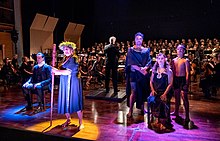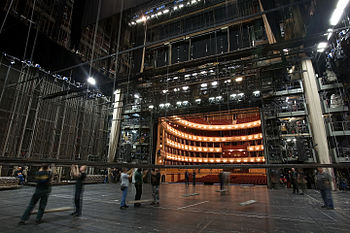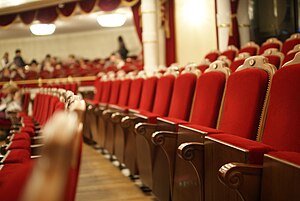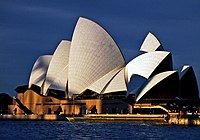Bruce Black Box Theater of Open Space for Arts Community


A theater, theatre or playhouse, is a structure where theatrical works, performing arts and musical concerts are presented. The theater edifice serves to define the performance and audition spaces. The facility usually is organized to provide support areas for performers, the technical crew and the audience members, as well equally the stage where the functioning takes place.
There are as many types of theaters as there are types of performance. Theaters may be congenital specifically for a sure types of productions, they may serve for more full general operation needs or they may be adapted or converted for use as a theater. They may range from open-air amphitheaters to ornate, cathedral-like structures to simple, undecorated rooms or black box theaters. A theatre used for opera performances is called an opera business firm. A theater is non required for performance (as in ecology theater or street theater), this article is virtually structures used specifically for performance. Some theaters may have a stock-still interim area (in near theaters this is known as the phase), while some theaters, such as black box theaters have movable seating allowing the production to create a performance surface area suitable for the production.
Elements of a theater building [edit]


A theater building or construction contains spaces for an event or performance to take place, usually called the stage, and also spaces for the audition, theater staff, performers and coiffure before and after the event.[1]
There are usually two main entrances of a theater building. Ane is at the front end, used by the audition, and leads into a entrance hall and ticketing. The second is called the stage door, and it is accessible from backstage. This is where the bandage and coiffure enter and exit the theater, and fans sometimes wait exterior it after the bear witness in order to get autographs, called "stage dooring".
Stage [edit]
The acting or performance space is the stage. In some theaters, such as proscenium theaters, arena theaters and amphitheaters, this area is permanent part of the structure. In some theaters the stage area tin can be changed and adapted specifically to a production, often called a black box theater, due to the common practice of the walls beingness painted black and hung with blackness drapes.[1]
Backstage and offstage [edit]
Usually in a building used specifically for performance there are offstage spaces used by the performers and coiffure. This is where props, sets and scenery are stored, and the performers standby earlier their entrance. These offstage spaces are called wings on either side of a proscenium stage. A prompter's box may be found backstage. In an amphitheater, an area behind the stage may be designated for such uses while a blackbox theater may have spaces outside of the bodily theater designated for such uses.
Often a theater will incorporate other spaces intended for the performers and other personnel. A booth facing the stage may exist incorporated into the firm where lighting and audio personnel may view the prove and run their corresponding instruments. Other rooms in the edifice may exist used for dressing rooms, rehearsal rooms, spaces for constructing sets, props and costumes, equally well as storage.
Seating and audience [edit]

Maryland Theatre in Hagerstown, Maryland, showing the stage, proscenium and seating
All theaters provide a space for an audience. In a fixed seating theatre the audience is often separated from the performers by the proscenium arch. In proscenium theaters and amphitheaters, the proscenium arch, like the stage, is a permanent feature of the construction. This area is known as the auditorium or the house.[2]
The seating areas can include some or all of the following:

- Stalls or arena (in Northward America, "orchestra"): the lower flat area, unremarkably below or at the same level as the stage. The word parterre (occasionally, parquet) is sometimes used to refer to a particular subset of this area. In Northward American usage this is unremarkably the rear seating block beneath the gallery (see beneath) whereas in Britain information technology tin can mean either the area in front almost the orchestra pit, or the whole of the stalls. The term can besides refer to the side stalls in some usages. Derived from the gardening term parterre, the usage refers to the sectioned pattern of both the seats of an auditorium and of the planted beds seen in garden structure. Throughout the 18th century the term was too used to refer to the theater audition who occupied the parterre.
- Balconies or galleries: i or more raised seating platforms towards the rear of the auditorium. In larger theaters, multiple levels are stacked vertically above or backside the stalls. The offset level is usually called the dress circle or grand circle. The next level may exist the loge, from the French version of loggia. A second tier inserted beneath the primary balcony may be the mezzanine. The highest platform, or upper circle, is sometimes known as "the gods", peculiarly in big opera houses, where the seats can exist very high and a long distance from the stage.
- Boxes (state box or stage box): typically placed immediately to the front, side and in a higher place the level of the stage. They are often separate rooms with an open viewing area which typically seat up to five people. These seats are typically considered the virtually prestigious of the house. A "state box" or "imperial box" is sometimes provided for dignitaries.
- Business firm seats: these are "the all-time seats in the house", giving the best view of the stage. Though each theater'due south layout is different, these are usually in the center of the stalls. These seats are traditionally reserved for the cast and crew to invite family members, agents, and others. If they are non used, they commonly continue sale on the solar day of the performance.
History [edit]
Open up-air theaters [edit]

The ancient theater in Delphi, Greece
Ancient Greece [edit]
Greek theater buildings were called a theatron ('seeing place'). The theaters were large, open-air structures constructed on the slopes of hills. They consisted of three principal elements: the orchestra, the skene, and the audience.
The centerpiece of the theater was the orchestra, or "dancing place", a big round or rectangular area. The orchestra was the site of the choral performances, the religious rites, and, perchance, the acting. An altar was located in the middle of the orchestra; in Athens, the altar was dedicated to Dionysus.
Behind the orchestra was a large rectangular edifice called the skene (meaning "tent" or "hut"). It was used as a "backstage" expanse where actors could change their costumes and masks, but also served to represent the location of the plays, which were unremarkably set in front of a palace or house. Typically, there were ii or three doors in the skene that led out onto orchestra, and from which actors could enter and leave. At first, the skene was literally a tent or hut, put up for the religious festival and taken downwards when it was finished. Later, the skene became a permanent stone structure. These structures were sometimes painted to serve as backdrops, hence the English give-and-take scenery. A temple nearby, especially on the correct side of the scene, is almost always part of the Greek theater complex, which could justify, as a transposition, the recurrence of the pediment with the later solidified rock scene.[3]
In front of the skene in that location may have been a raised acting area called the proskenion, the ancestor of the modern proscenium stage. Information technology is possible that the actors (equally opposed to the chorus) acted entirely on the proskenion, just this is not sure.
Ascent from the circumvolve of the orchestra was the audience. The audience sat on tiers of benches built up on the side of a hill. Greek theaters, and then, could only be built on hills that were correctly shaped. A typical theater was enormous, able to seat effectually 15,000 viewers.
Greek theaters were non enclosed; the audience could see each other and the surrounding countryside as well as the actors and chorus.
 | The Theatre at Athens From Dorpfeld and Reisch, Das griechische Theater (Athens, 1896), as presented in the commodity on "Theatre" from the 1911 edition of Encyclopædia Britannica. | |
| ab, | double western wall. | |
| bc, | single wall. | |
| aa, gg, | walls terminating wings of auditorium. | |
| b, f, | entrances. | |
| c, | the "katatome" (where the stone of the Acropolis was met by the walls). | |
| d, eastward, | diazoma. | |
| fg, | eastern purlieus wall. | |
| hh, | front wall of Neronian stage. | |
| i, | fragment 5th-century orchestra. | |
| klm, | ancient masonry (? of supporting walls). | |
| nn, | oldest phase buildings. | |
| oo, | rock proscenium (1st or second century B.C. ). | |
| p, | foundations of Neronian side wings. | |
| qr, | fragments 5th-century orchestra. | |
| s, | 4th-century portico. | |
| t, | old Dionysus temple. | |
Aboriginal Rome [edit]

The Romans copied the Greek way of edifice, only tended not to exist and then concerned well-nigh the location, beingness prepared to build walls and terraces instead of looking for a naturally occurring site.
The auditorium (literally "identify for hearing" in Latin) was the expanse in which people gathered, and was sometimes constructed on a small hill or gradient in which stacked seating could be hands made in the tradition of the Greek Theatres. The central part of the auditorium was hollowed out of a hill or slope, while the outer radian seats required structural support and solid retaining walls. This was of course not always the case as Romans tended to build their theatres regardless of the availability of hillsides. All theatres congenital inside the city of Rome were completely man-made without the utilize of earthworks. The auditorium was not roofed; rather, awnings (vela) could be pulled overhead to provide shelter from pelting or sunlight.[iv]
Some Roman theatres, synthetic of wood, were torn downward after the festival for which they were erected concluded. This exercise was due to a moratorium on permanent theatre structures that lasted until 55 BC when the Theatre of Pompey was built with the addition of a temple to avoid the law. Some Roman theatres evidence signs of never having been completed in the first identify.[5]
Inside Rome, few theatres take survived the centuries following their construction, providing little evidence well-nigh the specific theatres. Arausio, the theatre in modern-day Orange, France, is a good example of a classic Roman theatre, with an indented scaenae frons, reminiscent of Western Roman theatre designs, however missing the more than ornamental construction. The Arausio is notwithstanding continuing today and, with its amazing structural acoustics and having had its seating reconstructed, can be seen to be a curiosity of Roman architecture.[iv]
Elizabethan England [edit]

During the Elizabethan era in England, theaters were synthetic of wooden framing, infilled with wattle and daub and roofed with thatch. Mostly the theaters were entirely open air. They consisted of several floors of covered galleries surrounding a courtyard which was open to the elements. A big portion of the audience would stand in the thousand, directly in front of the stage. This layout is said to derive from the do of holding plays in the one thousand of an inn. Archaeological excavations of The Rose theater at London's Bankside, built 1587, have shown that it had en external diameter of 72 feet (22 metres). The nearby World Theatre (1599) was larger, at 100 feet (30 metres). Other evidence for the round shape is a line in Shakespeare'southward Henry 5 which calls the building "this wooden O", and several rough woodcut illustrations of the city of London.

Around this time, the green room, a place for actors to wait until required on phase, became common terminology in English theaters.
The Globe has now been rebuilt as a fully working and producing theater nearly its original site (largely thanks to the efforts of picture director Sam Wanamaker) to give modern audiences an idea of the environment for which Shakespeare and other playwrights of the period were writing.
Indoor theaters [edit]
Renaissance Europe [edit]
During the Renaissance, the commencement modernistic enclosed theaters were constructed in Italy. Their structure was similar to that of ancient theaters, with a cavea and an architectural scenery, representing a metropolis street. The oldest surviving examples of this style are the Teatro Olimpico in Vicenza (1580) and the Teatro all'antica in Sabbioneta (1590).
At the beginning of 17th century theaters had moved indoors and began to resemble the system we see most frequently today, with a stage separated from the audience by a proscenium arch. This coincided with a growing interest in breathtaking elements painted in perspective, such as those created by Inigo Jones, Nicola Sabbatini and the Galli da Bibiena family. The perspective of these elements could only be viewed properly from the heart back of the auditorium, in the so-called "duke'due south chair." The higher one's status, the closer they would exist seated to this vantage point, and the more the accurately they would be able to see the perspective elements.
The first enclosed theaters were court theaters, open but to the sovereigns and the nobility. The first opera house open to the public was the Teatro San Cassiano (1637) in Venice. The Italian opera houses were the model for the subsequent theaters throughout Europe.
German operatic influence [edit]
Richard Wagner placed great importance on "mood setting" elements, such every bit a darkened theater, audio effects, and seating arrangements (lowering the orchestra pit) which focused the attention of audience on the stage, completely immersing them in the imaginary earth of the music drama. These concepts were revolutionary at the time, but they have since come to be taken for granted in the modern operatic environment as well as many other types of theatrical endeavors.
Gimmicky theaters [edit]
Contemporary theaters are oft non-traditional, such as very adjustable spaces, or theaters where audition and performers are not separated. A major example of this is the modular theater, notably the Walt Disney Modular Theater. This big theater has floors and walls divided into small movable sections, with the floor sections on adjustable hydraulic pylons, so that the space may be adjusted into any configuration for each individual play. As new styles of theater functioning take evolved, so has the desire to improve or recreate performance venues. This applies as to creative and presentation techniques, such as phase lighting.
Specific designs of contemporary live theaters include proscenium, thrust, blackness box theater, theater in the round, amphitheater, and arena. In the classical Indian dance, Natya Shastra defines three stage types. In Australia and New Zealand a small and uncomplicated theater, particularly ane contained within a larger venue, is called a theatrette.[six] The word originated in 1920s London, for a small-calibration music venue.[7]
Theatrical performances can also take identify in venues adapted from other purposes, such as train carriages. In recent years the Edinburgh Fringe has seen performances in an Hover Car and a taxi.
Asian theater blueprint [edit]
Noh [edit]

i: hashigakari. two: kyōgen spot. 3: stage attendants. 4: stick drum. 5: hip drum. 6: shoulder drum. seven: flute. eight: chorus. nine: waki seat. 10: waki spot. 11: shite spot. 12: shite-bashira. xiii: metsuke-bashira. 14: waki-bashira. 15: fue-bashira.
The traditional stage used in Noh theater is based on a Chinese design. It is completely open, providing a shared experience betwixt the performers and the audience throughout the play. Without whatsoever prosceniums or defunction to obstruct the view, the audience sees each actor at moments even before entering the chief platform of the stage. The theater itself is considered symbolic and treated with reverence both past the performers and the audience.[eight]
The stage includes a large square platform, devoid of walls or curtains on 3 sides, and traditionally with a painting of a pino tree at the dorsum. The platform is elevated above the identify where the audition sits, which is covered in white gravel soil. The iv phase corners are marked by cedar pillars, and the whole is topped past a roof, fifty-fifty when the Noh stage is erected indoors. A ceramic jar arrangement under the stage amplifies the sounds of dancing during the performance. There is a modest door to permit entry of the musicians and vocalists.
The independent roof is one of the most recognizable feature of the Noh stage. Supported past four columns, the roof symbolizes the sanctity of the stage, with its architectural pattern derived from the worship pavilion (haiden) or sacred trip the light fantastic pavilion (kaguraden) of Shinto shrines. The roof too unifies the theater space and defines the stage as an architectural entity.[8]
The pillars supporting the roof are named shitebashira (principal character's pillar), metsukebashira (gazing colonnade), wakibashira (secondary grapheme'southward colonnade), and fuebashira (flute colonnade), clockwise from upstage right respectively. Each pillar is associated with the performers and their deportment.[9]
The stage is fabricated entirely of unfinished hinoki, a Japanese cypress, with almost no decorative elements. The poet and novelist Toson Shimazaki writes that "on the stage of the Noh theater there are no sets that change with each piece. Neither is there a curtain. In that location is but a simple panel (kagami-ita) with a painting of a green pine tree. This creates the impression that anything that could provide any shading has been banished. To pause such monotony and make something happen is no like shooting fish in a barrel thing."[viii]
Another unique feature of the stage is the hashigakari, a narrow span at upstage right used past actors to enter the stage. Hashigakari ways "break bridge", signifying something aerial that connects two separate worlds on a same level. The span symbolizes the mythic nature of Noh plays in which otherworldly ghosts and spirits ofttimes appear. In contrast, hanamichi in Kabuki theaters is literally a path (michi) that connects two spaces in a single world, thus has a completely different significance.[eight]

A contemporary Noh theatre with indoor roofed structure
Kabuki [edit]

Shibai Ukie ("A Scene from a Play") by Masanobu Okumura (1686–1764), depicting Edo Ichimura-za theater in the early 1740s
The Japanese kabuki stage features a project chosen a hanamichi (花道; literally, blossom path), a walkway which extends into the audience and via which dramatic entrances and exits are fabricated. Okuni as well performed on a hanamichi stage with her entourage. The stage is used non only as a walkway or path to become to and from the main stage, merely important scenes are also played on the stage. Kabuki stages and theaters have steadily become more technologically sophisticated, and innovations including revolving stages and trap doors were introduced during the 18th century. A driving force has been the want to manifest one frequent theme of kabuki theater, that of the sudden, dramatic revelation or transformation.[10] A number of phase tricks, including actors' rapid appearance and disappearance, utilize these innovations. The term keren (外連), often translated playing to the gallery, is sometimes used as a catch-all for these tricks. Hanamichi and several innovations including revolving stage, seri and chunori have all contributed to kabuki play. Hanamichi creates depth and both seri and chunori provide a vertical dimension.
Koothambalam [edit]

Koothambalam Theatre Exterior
The Indian Koothambalam temple is a space used to perform Sanskrit drama. Called the koothambalam or kuttampalam, it is a large high-degree rectangular, temple in Kerala which represented a "visual sacrifice" to whatsoever deities or gods of the temple. They were built for kutiyattam or "combined acting" performances, which merely 2 dramas are performed today.[11]
The temple has a pyramidal roof, with high walls, and a high-ceilinged interior. Within the large temple has a stage inside which is a big platform with its own pyramid roof. The stage area is separate from the audience expanse with the musician (a drummer on a high seat) behind the stage, and dressing rooms also at the rear with exit doors backside. The audience would be seated on a smooth, polished flooring. Several Koothambalams exist within several Indian temples,[ clarification needed ] [ does this mean several in each? ] and follow the same rectangular plan and structure.
See also [edit]
- Auditorium
- Amusement
- Learning space
- Listing of national theaters
- The Theatre of Small Convenience, the smallest theater in the world
References [edit]
- ^ a b "Theatre pattern | architecture". Britannica . Retrieved February 19, 2022.
- ^ "It's Non Only a Stage". The Kennedy Center . Retrieved Feb xix, 2022.
- ^ Brnić, Ivica (2019). Nahe Ferne: Sakrale Aspekte im Prisma der Profanbauten von Tadao Ando, Louis I. Kahn und Peter Zumthor. Zurich: Park Books. p. 78-79. ISBN978-three-03860-121-0.
- ^ a b Richard Allan Tomlinson. "Theatres (Greek and Roman), structure", The Oxford Companion to Classical Civilization. Ed. Simon Hornblower and Antony Spawforth. Oxford Academy Printing, 1998. Oxford Reference Online. Oxford University Press. Northwestern Academy. 11 May 2007.
- ^ Constance Campbell. "The Uncompleted Theatres of Rome", The Johns Hopkins University Printing. Theatre Journal 55.one (2003) 67–79 x May 2007.
- ^ Moore, Bruce 1999. The Australian Oxford Dictionary ISBN 0-nineteen-551796-2
- ^ "theatrette". Oxford English language Dictionary (2 ed.). 1989.
- ^ a b c d Komparu, Kunio (1983). The Noh Theater: Principles and Perspectives. New York / Tokyo: John Weatherhill, Inc. ISBN0-8348-1529-X.
- ^ Brockett, Oscar K.; Hildy, Franklin J. (2007). History of the Theatre (Foundation ed.). Boston, MA: Allyn and Bacon. ISBN978-0-205-47360-1.
- ^ Scott, A. C. (1955). The Kabuki Theatre of Nihon . London: George Allen & Unwin Ltd.
- ^ Sorgenfrei, Carol Fisher, et al. Theatre Histories: An Introduction. 2nd ed., Routledge, 2007.
External links [edit]
- Carthalia – Theatres on Postcards (pictures of theaters)
- Music Hall and Theatre History Contains archive material on hundreds of British Theater buildings.
- European Theatre Architecture A database of theatre buildings in Europe.
Source: https://en.wikipedia.org/wiki/Theater_%28structure%29



0 Response to "Bruce Black Box Theater of Open Space for Arts Community"
Post a Comment